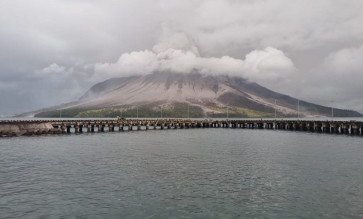Muslim fashion fest goes green, takes journey to the East
Into history: Designer Agus Sunandar showcases ethnic-inspired designs based on the visual culture of Sampang, East Java
Change Size

Into history: Designer Agus Sunandar showcases ethnic-inspired designs based on the visual culture of Sampang, East Java.
Long hemlines and A-line silhouettes remain the bread and butter of Muslim fashion everywhere, but the Muslim Fashion Festival (MUFFEST), in its fifth edition this year, gave the Muslim fashion world something new.
Nearly 55,000 visitors descended upon the Jakarta Convention Center, which hosted the event, bringing with them transactions valued at Rp 43.7 billion (US$3.15 million).
Here are some of the highlights of the Indonesian Fashion Chamber’s fashion extravaganza, which wrapped up its four-day run on Sunday.
Journey To The East
Taking inspiration from other cultures is nothing out of the ordinary in the fashion industry, as many designers and regular observers can attest.
At this year’s fashion festival, many of the designers and labels looked to Asian influences to inspire their latest collections, from the streamlined cuts of Japan to the intricate patterns of Turkey.
The land of the rising sun is always a favorite, from its traditional kimono-esque cuts to the kooky, loud elements of modern-day Harajuku.
Designer Saptalia sent models down the runway in floral floor-length pieces with prints reminiscent of traditional paintings, all the while holding parasols.
The Korean Wave, which is probably South Korea’s most significant cultural export to the world, clearly inspired Chaera Lee, as seen through the Hanbok-like styles in her collection, as well as her general styling cues, many of which could be found on the streets of Seoul.
Barli Asmara’s foray into the Muslim modestwear market took India as its main inspiration, with details evoking the neelakurinji flower, which only blooms once every 12 years.

Outside The Box
Regular fashion shows tend to be straightforward in formula; each model walks the runway before parading for the finale, and the designer usually comes out to take a bow. The overall presentation is usually done in around 15 minutes.
While most designers at the festival followed the usual formula, others chose to inject a little something to make their latest lines more memorable than the rest.
Agus Sunandar created ethnic-inspired designs based on the visual culture of Sampang, East Java. They were opulent in their intricacies. The collection’s pièce de résistance was the headpiece, which literally embodied the area’s traditional seafaring history through its boat-like forms.
Lisa Fitria conveyed an environmental message by presenting a meme likening trash to an ex-lover — both needing to be tossed in the bin.
The festival’s most meme-able moment, however, was Hannie Hananto’s collection Generasi Micin (MSG Generation), a popular term that pokes fun at millennials’ affinity for monosodium glutamate in their instant noodles.
As gimmicky as it was, creating a collection inspired by the trend, set to the runway beats of Didi Kempot, was certainly a memorable act. And that’s not to mention the TikTok dance to open and close the presentation itself.

Going Green
As conversations on climate change are no longer confined to hippies in tie-dyed shirts, many institutions and brands have taken a more ecologically friendly path to their usual business.
This year’s MUFFEST took the theme “Fashionable People for Sustainable Planet”. It sought a greener approach to the industry, which has been projected by the State of the Global Islamic Economy study to be worth $402 billion globally in 2024.
Riau-based viscose-rayon producer Asia Pacific Rayon (APR) returned to this year’s MUFFEST, collaborating with a number of designers to create collections using natural fiber fabrics.
Reducing the use of polyester is beneficial to the environment, as studies have shown the synthetic fabric sheds microplastics during the wash cycle that ultimately end up in the ocean.
The question remains — is switching to biodegradable fabrics enough to propel the fashion industry into a state of sustainability often touted in reports and speeches?
Designer Nuniek Mawardi said before her show on the final day that sustainability started with the simplest of things, such as managing waste fabric from production and wise spending on materials.
The case in point was her own collection, which she said had a “zero-waste concept” by having the garments made from rectangular pieces of fabric folded into a triangle. This had the effect of minimizing fabric waste through minimal cutting, as most of the fabric was utilized.
Fellow designer Rosie Rahmadi, who showcased her eponymous label’s latest collection in collaboration with APR, separately told The Jakarta Post her brands were also trying to minimize fabric waste by utilizing every inch possible through effective cutting.
“I also have another brand called Parapohon, which exclusively uses natural fabrics like linen and viscose-rayon. The brand has its own DNA, so it won’t be my regulars’ — who have a more formal style — cup of tea.”

Traditionalism: Saptalia's kimono-esque cuts were some of the many designs at the festival that took inspiration from Japan. Other favorites included South Korea, Turkey and India.
In launching Rosie’s menswear line, Rosie Rahmadi Homme, she mixed pieces of Parapohon into the presentation, paired with items cut from APR’s fabrics.
After a garment has been purchased, sustainability crops up in its life cycle.
Nuniek chose the path of “upcycling”. “I often redesign my own products. My consumers pay a fee to have it done, but they can have a new look from it, thus extending the life of the garment and keeping it from going to waste,” she said.
Meanwhile, Rosie chose to campaign for a more edited wardrobe through her Gadiza line, where the tags stress the importance of wardrobe essentials.
“It’s the era of Instagram, where people may not want to repeat clothes already posted and end up buying cheap clothes. My campaign is that you don’t need a lot of clothes, just a few that you can mix and match accordingly,” she said.
As for the use of environmentally friendly fabrics, Nuniek herself did not think it was the only way forward. If a garment used polyester fabrics, it had to have a unique design or value so as to prolong its life cycle, she explained.
Rosie said if the design and fabric used were good, the item would not be forgettable.
“In principle, we need to create clothes that consumers actually love. Basically, create the best we can,” she said.
Aside from the garments, Rosie said the mindset for sustainability started from within, such as by using less single-use plastic and by curbing water and electricity usage.
Nuniek echoed her sentiments, saying that sustainability for a brand could also be applied in the human resources department, adding that employees’ wages and work hours also came into the equation. “Sustainability doesn’t just end at using natural fibers. We have to keep the smallest details in our mind.” (ste)
— Photos courtesy of MUFFEST









